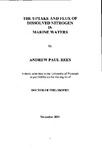THE UPTAKE AND FLUX OF DISSOLVED NITROGEN IN MARINE WATERS
| dc.contributor.author | REES, ANDREW PAUL | |
| dc.contributor.other | School of Biological and Marine Sciences | en_US |
| dc.date.accessioned | 2013-09-16T08:16:34Z | |
| dc.date.available | 2013-09-16T08:16:34Z | |
| dc.date.issued | 2001 | |
| dc.identifier | NOT AVAILABLE | en_US |
| dc.identifier.uri | http://hdl.handle.net/10026.1/1719 | |
| dc.description.abstract |
The biological uptake and transformation of inorganic nitrogen species is described for contrasting marine environments which include a sea loch, riverine plume, polar marginal ice-zone, continental shelf break, oligotrophic ocean and a mesoscale eddy. Uptake of nitrate and ammonium by phytoplankton has been determined using the stable isotope as a tracer and continuous flow stable isotope-ratio mass spectrometry. The analysis of dissolved and atmospheric nitrous oxide was made using electron capture detector gas chromatography in a novel configuration which also allowed for the simultaneous analysis of methane from a single sample. Significant advances in the study of the marine nitrogen cycle have been made and presented to the scientific community via publication in high quality research journals and by the placement of data into the British Oceanographic Data Centre. These are important from local and global perspectives; information on the trophic status of seawaters is presented with respect to seasonal and hydrographical variability, as is the contribution made to knowledge regarding the role of nitrogen in climate change. Nitrogen availability is limiting in many oceans and attempts to constrain the global atmosphere - ocean fluxes of CO2 are based on basin scale nitrogen balances. The development of novel analytical procedures and their subsequent use during a number of field programs and modeling exercises has increased the available knowledge regarding the role of nitrogen in the removal of carbon to the deep ocean. In particular new insights into new production and ultimately carbon export have been made, these include: (i) The accepted threshold limit for phytoplankton uptake of nitrate in the oligotrophic ocean has been reduced from 0.016 to 0.005 mmol m ^ (ii) a relationship has been described relating the size structure of the phytoplankton productivity to new production which can be used as a direct estimate of carbon export, (iii) a series of algorithms have been produced to allow the basin scale estimation of new production from satellite and ship derived data, and (iv) whilst nitrous oxide plays a significant role in radiative forcing and stratospheric ozone depletion, an area in the Southern Ocean was found to provide a seasonal sink to atmospheric N2O. | en_US |
| dc.language.iso | en | en_US |
| dc.publisher | University of Plymouth | en_US |
| dc.title | THE UPTAKE AND FLUX OF DISSOLVED NITROGEN IN MARINE WATERS | en_US |
| dc.type | Thesis | |
| plymouth.version | Full version | en_US |
| dc.identifier.doi | http://dx.doi.org/10.24382/4324 | |
| dc.identifier.doi | http://dx.doi.org/10.24382/4324 |
Files in this item
This item appears in the following Collection(s)
-
01 Research Theses Main Collection
Research Theses Main


